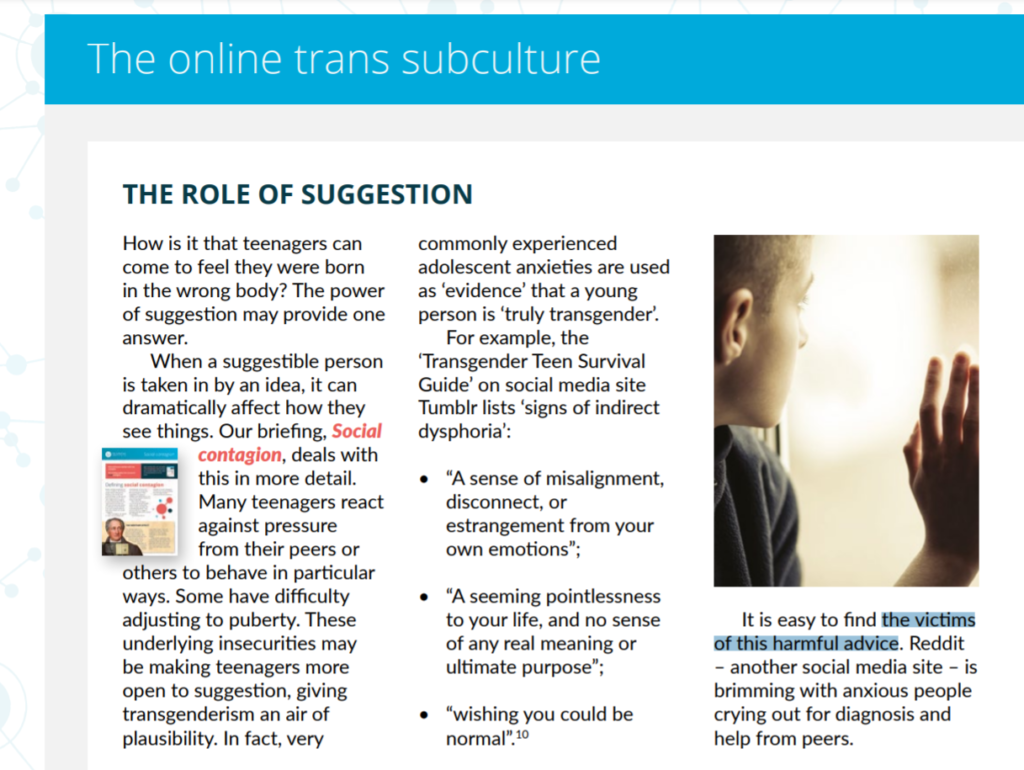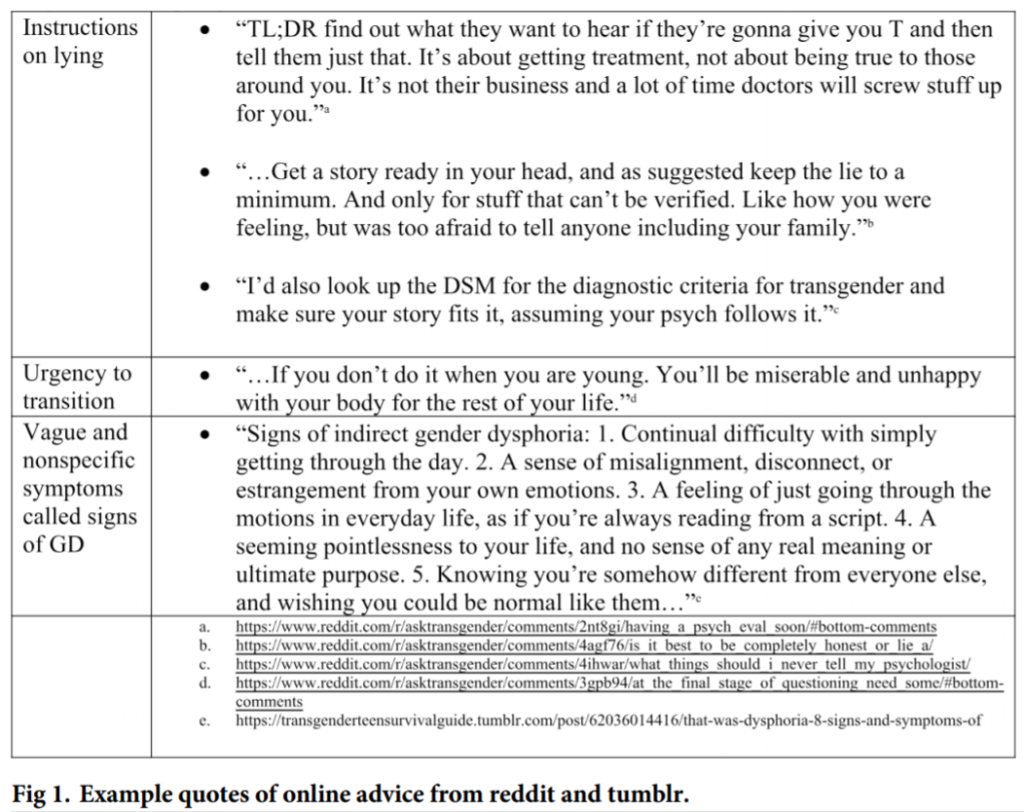 The UK’s Christian Institute, in their September 2020 publication “The transgender craze” purporting to explain a “social contagion” of “rapid-onset gender dysphoria” in adolescents, takes a highly abbreviated excerpt from my own writing in 2013 on gender dysphoria and symptoms of depersonalization, a highly distressing dissociative syndrome that can occur more frequently among trans people and often remits following transition.
The UK’s Christian Institute, in their September 2020 publication “The transgender craze” purporting to explain a “social contagion” of “rapid-onset gender dysphoria” in adolescents, takes a highly abbreviated excerpt from my own writing in 2013 on gender dysphoria and symptoms of depersonalization, a highly distressing dissociative syndrome that can occur more frequently among trans people and often remits following transition.
The Christian Institute asserts that these are “very commonly experienced adolescent anxieties” being incorrectly “used as ‘evidence’ that a young person is ‘truly transgender’”, and that “anxious people crying out for diagnosis and help from peers” are “the victims of this harmful advice”. The misattribution of my article to “Transgender Teen Survival Guide” appears to be copied from an error by Lisa Littman in her original 2018 publication on “Rapid-onset gender dysphoria in adolescents and young adults”, where a similar excerpt is described as “Vague and nonspecific symptoms called signs of GD”.
Once I pointed out in the Brown Daily Herald that my original article on depersonalization disorder in trans people had been misattributed and mislabeled as “Vague and nonspecific symptoms” in her paper, Littman appeared to acknowledge that my work may not have been an example of those vague symptoms and that depersonalization is indeed a real condition. Littman went on to clarify this in her corrected 2019 publication on “Parent reports of… signs of a rapid onset of gender dysphoria”:
The purpose of Fig 1 was to provide the reader with a quick sense of what kinds of advice can be found and shared on Reddit and Tumblr. One example includes an excerpt from a publicly available Tumblr blog that posted a list of purported indirect signs of gender dysphoria. This excerpt is indeed an example of advice that can be found on Tumblr. Note, however, that the excerpted Tumblr post itself does not reflect the full content of the original blog it refers to, nor does the excerpt in Fig 1. The original blog is titled, “‘That was dysphoria?’ 8 signs and symptoms of indirect gender dysphoria” [15].
The Christian Institute, and Littman originally, reduced a detailed 3,300-word article on my personal experiences of depersonalization to 3-5 sentences heard secondhand from an unrelated Tumblr blog. Both omitted the central points of my article connecting this dissociative syndrome to gender dysphoria, explaining that these distressing symptoms worsened at the onset of puberty and remitted once I started HRT. My words were made to appear vague and irrelevant by others stripping them of their details – I am not the one who created the essentially meaningless summaries offered by the Christian Institute and others.
My original article was repeatedly clear on the point that common anxieties are hardly surefire evidence that a person is trans or has gender dysphoria, and that dissociative symptoms such as depersonalization are not synonymous with transness and are experienced by cis people in the context of many other conditions:
Again, not all trans people will necessarily have all or any of these signs, as everyone’s gender dysphoria is different. Some people have more obviously gender-related symptoms than others. Similarly, not everyone with these signs is necessarily trans. They aren’t inherently limited to sufferers of gender dysphoria and can potentially be due to any of the other conditions previously listed, like garden-variety depression or anxiety disorders – but for some trans people, these are indeed symptoms which resolve once the dysphoria is addressed. … If you’ve been reevaluating your gender, and these experiences seem relatable to you, it may be worth considering that this could be gender dysphoria – and that it’s potentially treatable.
My work, being misused here by the Christian Institute on the foundation of a previous (and now-withdrawn) misuse, stated from the very outset that some trans people won’t have these symptoms and many people with these symptoms aren’t trans, and that some trans people do experience these symptoms in connection with their untreated gender dysphoria. My article addressed the latter group for whom this overlap is relevant. “Not all”, “everyone’s is different”, “some more than others”, “potentially due to any other conditions”, “if”, “seem”, “may”, “considering”, “could be” – this is not the language of immediate conclusive diagnosis or hasty generalization.
I’ve already gone on to explore at length the connections between chronic depersonalization and gender dysphoria throughout the lifespan and during medical transition, a further resource which I linked to in my original article in 2017 more than a year before Littman’s initial 2018 publication. Severe depersonalization disorder is a pervasive feeling of unreality or of one’s existence or emotions being unreal, a sensation that’s deeply distressing in very specific and vivid ways that are common to its sufferers and not at all vague. It’s associated with a significantly elevated prevalence of depression, anxiety, and suicidality, as well as severe impairments in functioning at work, school, and in personal relationships. Trans people with untreated gender dysphoria are several times more likely than cis people to experience depersonalization disorder, and symptoms of depersonalization markedly decrease after trans people medically transition.
For trans people with depersonalization, current evidence indicates transitioning can be a successful way to ameliorate the deep pain and overall functional impairment and loss of quality of life of this condition. That’s the subject I was addressing. It’s a subject I cover because this is important information for trans people who are suffering from a certain treatable condition and because this information can be used to reduce suffering. It should be obvious to anyone that this was not a call for all cis or trans people experiencing any vague distress to pursue transition as a certain cure for vague distress. Littman’s broader proposal of “rapid-onset gender dysphoria” promoted by the Christian Institute is itself deeply flawed and almost certainly false, which I’ve already examined in depth. But as improbable as it is, Littman and I currently appear to be on the same page in recognizing that depersonalization can be associated with gender dysphoria and is not a vague symptom. The Christian Institute has now been misrepresenting my work on this genuine condition for nearly a year.
I request that the Christian Institute remove the following passages from their document, as well as any reference to my work on depersonalization:
For example, the ‘Transgender Teen Survival Guide’ on social media site Tumblr lists ‘signs of indirect dysphoria’: “A sense of misalignment, disconnect, or estrangement from your own emotions”; “A seeming pointlessness to your life, and no sense of any real meaning or ultimate purpose”; “wishing you could be normal”.





